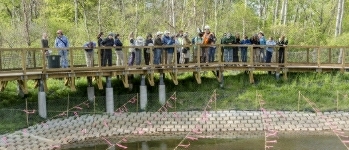By Beth Daley and Eric Moskowitz / Globe Staff / November 1, 2012
Boston may have been spared the worst this time, but will it be so lucky the next? Do not count on it, say researchers who argue that the city and its densely developed shoreline are extremely vulnerable to the more frequent and intense storms associated with global warming.
City transportation, utility, and hospital officials said they have worked hard in recent years to identify hotspots prone to flooding from big storms and, in some instances, started to prepare for higher seas. But some engineers and scientists said far more needs to be done to armor Boston against a one-two punch of more severe storms and seas that are rising at almost four times the global rate.
“How many times have you heard the words unprecedented, record-breaking, ‘We have never seen anything like this’ in the last three years?” asked Ellen Douglas, associate professor of hydrology at the University of Massachusetts Boston. Working with the Boston Harbor Association, she helped prepare map scenarios for the city that show large swaths of South Boston and East Boston and parts of the North End under 1 to 4 feet of water during high tide if there is a 5-foot storm surge, about half the wall of water that inundated Manhattan. “Sandy is a wake-up call,” Douglas said.
Hurricane Sandy has refocused political attention on climate change, largely absent in this campaign season, with both Senator Scott Brown and Elizabeth Warren addressing it during campaign stops in recent days. Mayor Michael Bloomberg of New York also unexpectedly endorsed President Obama yesterday, saying Obama is best suited to contend with the climate change problem brought into clear relief by Sandy.
While the hurricane was not directly attributable to global warming, scientists said it fits a pattern of more severe weather influenced by climate change.
Boston transportation officials expressed confidence in the transportation system, saying it has fared well during past storms, but also said the type of flooding New York and its subway system experienced would be devastating. In the last century, Massachusetts Bay Transportation Authority officials said, there has only been one severe flood in a subway tunnel, in October 1996 when a three-day storm caused the Muddy River to overflow. At least 14 million gallons of water gushed into the Green Line portal between Fenway and Kenmore with such force that it moved tons of rock 500 feet into the tunnel.
Today, the MBTA stations a person with a measuring stick at the Muddy River in severe storms and, when the river gets too high, shuts down service between the two stations and replaces it with busing. The MBTA also built Aquarium Station entrances as high as possible during a reconstruction a decade ago to account for flooding. Officials have also identified the stations most at risk of flooding and have plans to deal with high water, including sandbags and pumping.
Richard A Davey, the state transportation secretary, said it would be difficult to imagine a scenario in which water rose high enough to flood the Thomas P. O’Neill Tunnel or a tidal surge coming into the Seaport District and spilling into the Ted Williams Tunnel.
“At the same time in New York, it was probably difficult for New York to imagine, and it happened there this week,” Davey said.
Boston is not likely to take a hit exactly like New York, which suffered a more than 10-foot storm surge, flooding roads, subways, and tunnels. The Cape and South Shore tend to take the brunt of hurricanes, while Boston is more susceptible to nor’easters. Some government officials said the Boston Harbor Islands may also help buffer storm surges.
But the city will flood more frequently for other reasons. A recent US Geological Survey report found that Northeast sea levels are rising at almost four times the global rate from global warming. Boston, by several measures, is already experiencing more severe weather such as more intense rainstorms, which scientists have predicted would be triggered by climate change.
Gradually warming seas off the East Coast, which spiked to record highs this year, also can help fuel hurricanes as they travel north later in the season. New research in the warming Arctic points to changes in the jet stream that may have influenced Sandy’s path, although how influential it will be on Northeast storms in the future is unknown.
We “expect storm surges to become more destructive . . . because of more intense and larger storms and also because of general sea level rise,’’ Kerry Emanuel, professor of atmospheric science at MIT said in an e-mail. “We expect to see an increased incidence of freshwater flooding from hurricanes because they will produce more rain.”
Even before failed back-up generators forced the evacuation of hospitals in New York in recent days, some local hospitals have been working on fail-safe ways to ensure that the lights stay on during severe storms.
The Spaulding Rehabilitation Hospital, opening in 2013, positioned its ground floor and all openings into the garage below, 2½ feet above the current 500-year flood plain elevation to safeguard against sea level rise. They have put key electrical equipment on the rooftop penthouse and even installed operable windows in all patient rooms for ventilation in case they lose power. Massachusetts General Hospital, meanwhile, has moved emergency generators and equipment to high ground and has planned to do so for other campus buildings.
Boston has launched a “Green Ribbon” commission, including business and civic leaders, to fight climate change not just by reducing emissions, but by adapting to it by constructing buildings differently. The city already requires departments to take climate change into account in planning decisions. State officials are also requiring developers building in areas prone to coastal flooding to erect the lowest floor at least 2 feet above where water levels now rise during severe storms.
With waterfront development on the rise in the Seaport District, East Boston, and Charlestown, “we have the luxury and the opportunity of having a tremendous amount of waterfront real estate available for development, and we need to make sure this is done in a way that anticipates being prepared for and resilient for storms we expect to see,’’ said Brian Swett, chief of environment and energy for the city of Boston.
Beth Daley can be reached at bdaley@globe.com. Follow her on Twiter @Globebethdaley. Eric Moskowitz can be reached at emoskowitz@globe.com.
© Copyright 2014 Globe Newspaper Company.
- Home
- Directions
- FAR Wildlife Blog
- Calendar
- News
- Donate Now
- Get Social!
- Storm Water Wetlands
- Plants and Restoration
- Photos
- Videos
- About & Projects
- Master Plan for Alewife
- Archive
- Newsletters
- Contact
 Presentation Spotlighting Alewife Reservation
Presentation Spotlighting Alewife Reservation
 Follow us on Twitter
Follow us on Twitter
 Like us on Facebook
Like us on Facebook
 Follow us on Instagram
Follow us on Instagram
Forward our web address to a friend!
- An Urban Gem - Alewife Reservation Nature Preserve
- Envisioning The Silver Maple Forest
- History and Policies of Cambridge, Belmont, and DEP
- Storm Water Wetlands
- Friends of Alewife Reservation brochure
(front, back) - Technical Analysis of Upper Alewife Basin
- Watershed: An Excursion in Four Parts
- The River Is A Restless Spirit: Life in the floodplain forest
-
Assessment of Silver Maple forest for DEP Adjudicatory hearings and
Patrick Fairbairn, author of the Assessment - Community Native Garden Flora
The
Alewife Reservation
is a unique natural resource for the communities of Belmont, Arlington and Cambridge
and home to hundreds of species, including hawks, coyotes beavers, snapping turtles, wild turkeys and muskrats,
the reservation is a unique natural resource for the community.
Historical information (Powerpoint)
Friends of Alewife Reservation works to protect and restore this wild area and the surrounding area for the water quality, native plants, animals and over 90 bird species with paths for walking, running and biking, recreation, and for classroom education and research. We regularly steward and preserve the Reservation area for wildlife and for the enjoyment of present and future generations.

(video)
By-Laws
About Friends of Alewife Reservation
Statement of Purpose
Citizen Forester newsletter archive
The Birds of the Cambridge Region of Massachusetts

by William Brewster 1906
Nuttal Ornithological Society
Biodiversity Study of Alewife Reservation Area: Species, Habitat, Ecosystems

Inventories by David Brown, wildlife assessor (2003, 2004.) Published by and available from FAR for $10. Write or call for your copy. (sample)
Updated Dave Brown Inventories (2008, 2010)
Inventories of Alewife Reservation Wetland Plants by Walter Kittredge, Botanist (2013)

